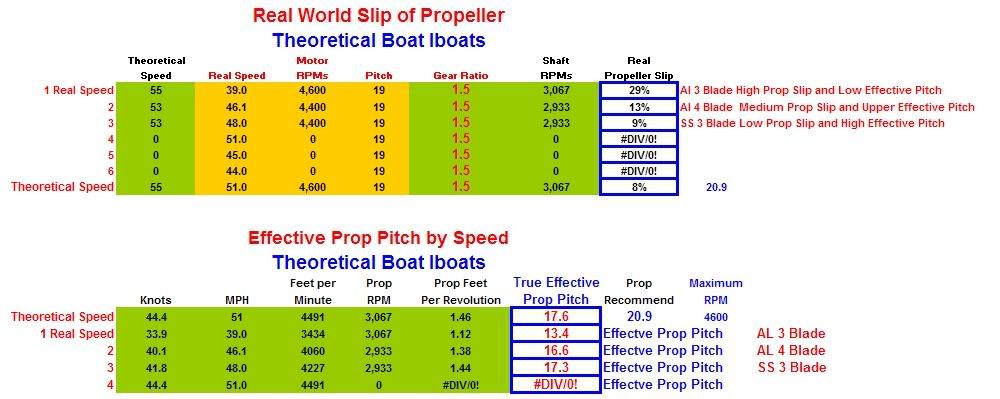Re: 8000 lb cruiser twin merc 260's
Smoke, on almost any boat I recommend that anytime prop slip is over 15% you need to change props to reduce prop slip. The only time this
may not be true is when you have a
very heavy boat that is
very underpowered. But your boat does not have this problem as you are only pushing about 18 # of weight for each HP you have, assuming the total boat weight is about 9,000 # fueled up with average equipment and with 4 people on board. I show the base weight of your boat to be about 7,200 #, if I am wrong please correct me.
My local prop shop guy tells me that on a big heavy boat "you gotta run the largest diameter you can fit" he goes on to explain that the biggest limiting factor is tip speed and erosion of the blades caused by it.
In my opinion, you should be talking about
blade surface area instead of the diameter, more blade surface area always transfers more thrust from a prop, if two different props have the same diameter, blade geometry and pitch. If you have too much blade surface area the motor may not have enough HP to reach its maximum upper recommended RPM even though you may have two props that have the exact same pitch and blade geometry, the other one could have too little blade surface area and thus actually turn too high RPM, assuming both props have the exact same blade geometry and pitch, except for blade surface area. But in
every case you are looking for the prop that produces as close to the amount of thrust required and very little more, or you increase the drag and are not able to reach the upper recommended RPM for your motor. When you do find a prop that is producing just the right amount of thrust needed with the commensurate amount of pitch, blade geometry and blade surface area prop slip will be as low as possible.
Smoke you mentioned
I am mostly looking for theoretical info.....
So, lets go through some of the theory on props.
1. Prop Slip and Effective prop pitch is not the same as Prop Efficiency as 45Auto says. But in my opinion it is more important than any manufacturers Prop Efficiency rating, because NO commerial manufacturers of props for outboards, inboards or inboard/outboards list the efficency rating for their props, so the term Prop Efficiency has NO meaning whatsoever for over 85% of ALL boats in the world. What we are actually looking for in a prop is the Highest EFFECTIVE Prop Pitch that still allows our motors to reach the
upper recommended manufacturers RPM, this will produce the highest speeds and the best fuel economy in almost all boats. Prop Slip and Effective prop pitch are directly proportional to the Prop Performance of any prop
on any particular boat and motor combination. If you can reach somewhere between 6% to 11% prop slip with as high an effective prop pitch as you can use you will have an excellent prop for most boats.
EFFETIVE PROP PITCH is the Actual distance a prop travels in one revolution while the stated Prop Pitch is the Theoretical distane a prop should travel in one revolution, so you can see that Prop Slip and Effective Prop Pitch are directly proportional to each other.
Prop Efficiency
2. So that brings us to Prop Slip, and as 45Auto states
Rather, slip is the difference between actual and theoretical travel
of a prop.
Prop Slip and the commensurate Effetive Prop Pitch
If you look at the above computations under Prop Slip and Effective Prop Pitch you can see that as we change props and the Prop slip goes down the Effective prop pitch goes up. Under this scenario these props produce these results.
1 Real Speed. The Aluminum 3 blade aluminum prop has very little blade surface area and minimal blade geometry and only has a 13.4" effective pitch with 29% prop slip.
2. While the 4 blade aluminum prop has minimal blade geometry as well but it has more blade surface area, and the 4th blade loses about 200 RPM, and thus it increases the effective prop pitch to 16.6" and the prop slip is only 13%.
3. Whereas the SS prop has much thinner blades, because it is SS and is much stronger and thus can be cast thinner, as well as the prop has much more blade geometry designed into it for better prop slip control, and thus has an effective prop pitch of 17.3" and a prop slip of 9%.
The above scenario is just an example of how blade surface area affects Effective prop pitch and thus the speed and fuel economy of a boat. I showed the SS prop as the best for the simple reason that in the real world that is normally the case, because SS props are normally faster, although if the boat is only capable of speeds in the 45 to 50 MPH range some Aluminum 4 blade props can be an excellent and economical alternative with very little loss of speed, usually about 1 to 3 MPH, and much cheaper.
H




















